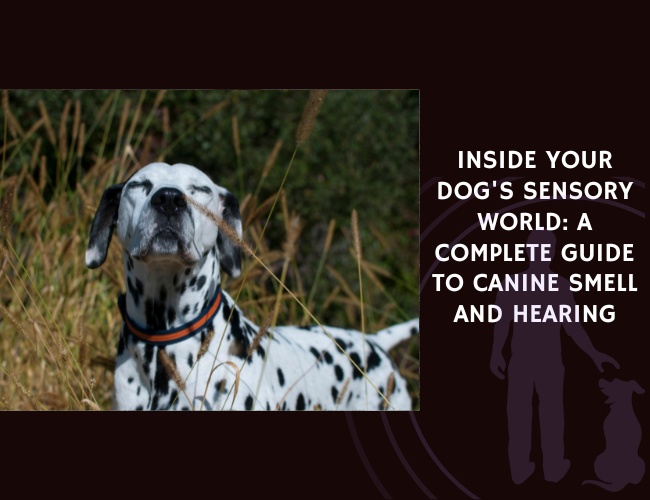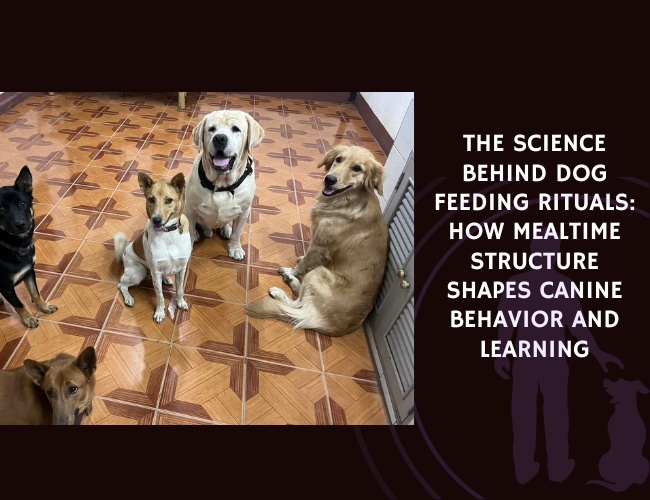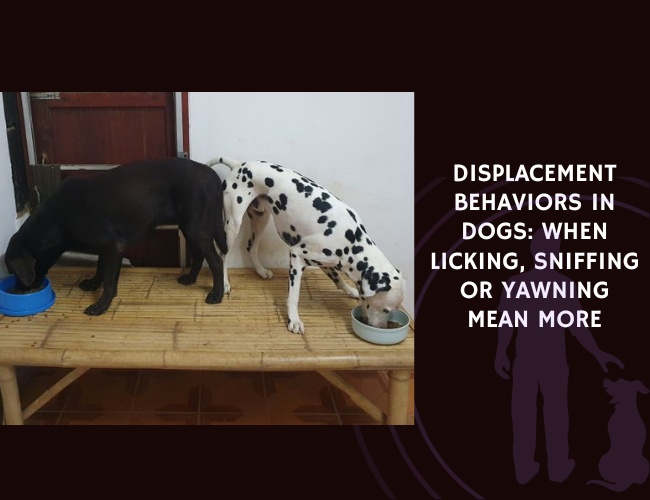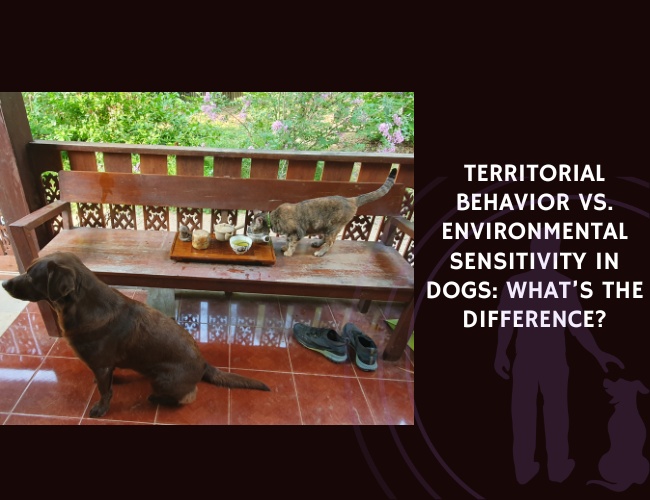Introduction to Canine Sensory Perception
Overview of Dogs’ Heightened Sensory Capabilities Compared to Humans
Dogs have evolved to possess extraordinary sensory capabilities, particularly in their sense of smell and hearing. These heightened senses are not just a quirky trait but serve essential functions in their daily lives. To grasp the extent of their sensory superiority, consider this: while humans have about 5 million olfactory receptors, dogs boast an impressive 300 million. Moreover, humans hear frequencies ranging from 20 Hz to 20,000 Hz, while dogs can detect sounds between 40 Hz and 60,000 Hz. This highly developed sensory perception enables dogs to pick up on stimuli that humans would completely miss.
Importance of Smell and Hearing in Dogs’ Daily Life and Survival
The sense of smell in dogs is astonishingly advanced. Imagine you are walking your dog in a park. While you might notice the scent of freshly cut grass, your dog is parsing through layers of information carried by scents – from the presence of other animals to your recent location. This powerful olfactory system allows dogs to detect scents at incredibly low concentrations, often measured in parts per trillion. It’s like being able to spot a grain of sugar in an Olympic-sized pool. This capability is not just about identifying food or friends; it’s crucial for survival, helping them navigate, hunt, and detect environmental changes.
Hearing also plays a vital role in a dog’s life. Their ability to hear high-pitched sounds and locate the direction of those sounds helps them spot potential dangers and communicate with other dogs. It’s this acute sense of hearing that makes them excellent guard dogs, alerting their owners to intruders or unfamiliar noises. In cases where vision might be impaired, dogs rely heavily on their auditory sense to understand and interact with their environment.
Evolutionary Advantages of Advanced Sensory Systems
Over thousands of years, these sensory enhancements have provided dogs with significant evolutionary advantages. The ability to detect subtle changes in the environment through smell and sound has aided dogs in evading predators, locating prey, and finding mates. For example, wolves, from which domestic dogs are descended, rely heavily on their sense of smell and hearing for hunting. These senses help them track and catch prey more efficiently, ensuring better survival rates.
Additionally, these advanced sensory systems have allowed dogs to form symbiotic relationships with humans, a partnership that has been beneficial to both species. Dogs assist in various human activities such as search and rescue, hunting, and providing emotional support. Their keen senses are also utilized in modern roles like detecting diseases, where their ability to identify specific volatile organic compounds related to illnesses can save lives.
Understanding these remarkable sensory capabilities provides a deeper insight into why dogs behave the way they do and how they interact with us and their environment.
With this foundational understanding of canine sensory perception, we can now explore the intricate details of each sense, beginning with the astonishing capabilities of the canine nose.
The Remarkable Canine Nose
Our journey into the sensory world of dogs brings us to an extraordinary apparatus—their nose. Dogs, unlike humans, are endowed with one of nature’s most advanced olfactory systems, opening a whole dimension of their world to us.
Anatomy of the Canine Olfactory System
The canine olfactory system is a marvel of biological engineering. It starts with the olfactory epithelium, a specially adapted tissue found inside the nasal cavity. This structure alone contains approximately 300 million olfactory receptors, a staggering number when you consider that humans only possess about 5 million of these receptors. This difference alludes to the incomparable sensitivity dogs have in detecting scents.
Adding to this, the olfactory bulb in dogs is notably large concerning their brain size. The olfactory bulb is the brain structure responsible for processing the information transmitted by the olfactory receptors. Its extensive size in dogs suggests a robust capacity for interpreting and distinguishing numerous smells, further emphasizing their superior sense of smell.
The Vomeronasal Organ
Another integral part of the canine olfactory system is the vomeronasal organ, also known as Jacobson’s organ. This structure detects pheromones, which are chemicals that serve as signals both within and between species. Pheromones influence critical behaviors such as mating, territory delineation, and aggression. Thus, the vomeronasal organ plays a crucial role in the social dynamics and reproductive activities of dogs.
Sensitivity and Detection Capabilities
Dogs’ olfactory capabilities allow them to detect substances at concentrations as low as parts per trillion. Imagine detecting a teaspoon of sugar dissolved in an Olympic-sized swimming pool—this is akin to the sensitivity of a dog’s nose. Dogs achieve this remarkable detection by manipulating airflow through their nostrils, enhancing their ability to capture and concentrate scents in the olfactory epithelium.
Additionally, dogs have an extraordinary ability to distinguish between a vast array of scents. They can tell apart thousands of different odors, making them ideal for tasks that require keen olfactory discrimination such as tracking and detection.
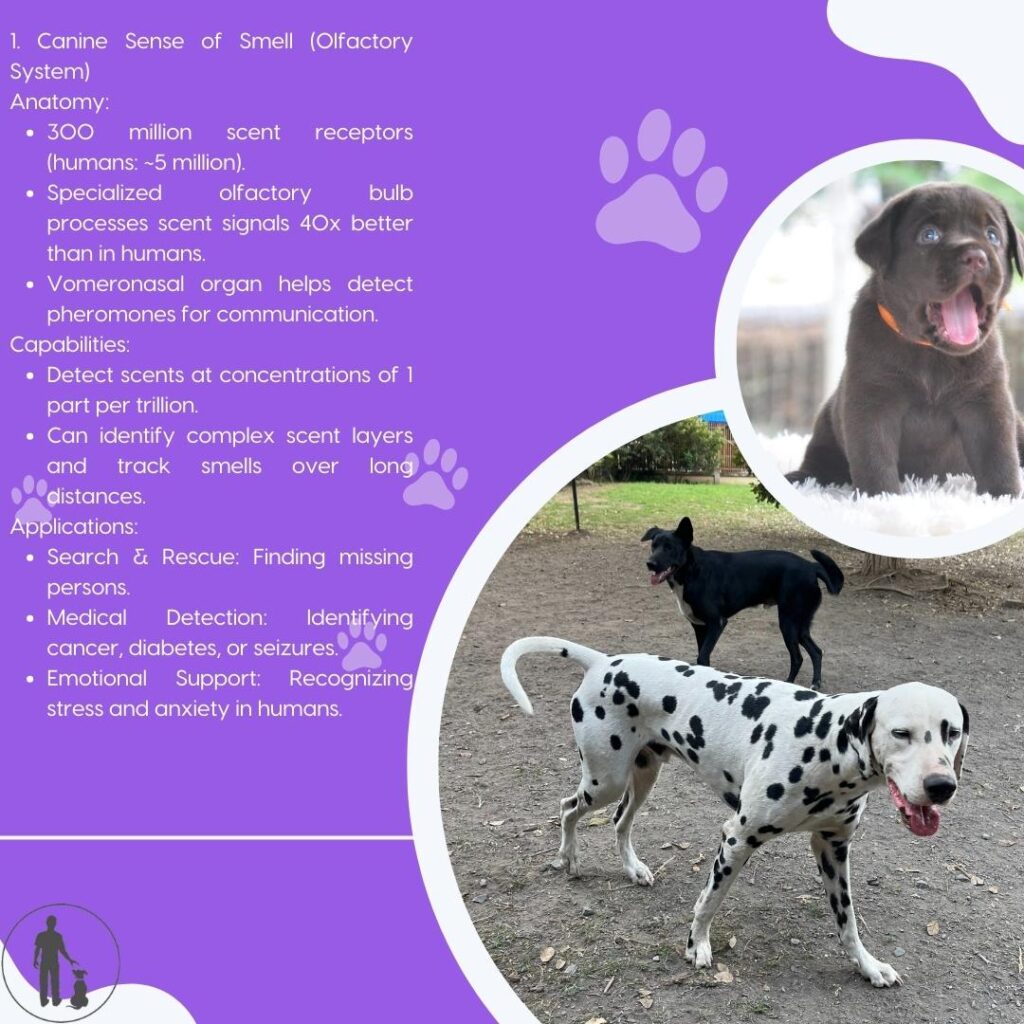
Real-World Implications
The real-world implications of this incredible sensory power are numerous. From aiding in search-and-rescue missions to helping diseases detection, dogs rely on their noses to perform tasks that are beyond human capability. This not only illustrates their practical importance but also highlights how their sensory capabilities can be harnessed for specialized and life-saving tasks.
The sophisticated olfactory system of dogs offers us a glimpse into their complex sensory world. Understanding the structure and function of this system highlights why their noses are often regarded as one of nature’s little miracles. As we continue our exploration of canine senses, we’ll soon delve into another critical sense—hearing.
Understanding Canine Hearing
Dogs have incredible auditory abilities that far surpass those of humans. These heightened capabilities are not just a neat biological feature; they play a critical role in their daily lives and survival. Let’s dive into the fascinating world of canine hearing and understand how dogs process sounds.
Structure and Function of the Canine Auditory System
The canine ear is a complex structure composed of three main parts:
- Outer ear (pinna): This funnel-shaped structure captures sound waves and directs them into the ear canal.
- Middle ear: Comprising the eardrum and three small bones (ossicles), this section amplifies and transmits sound vibrations to the inner ear.
- Inner ear: This part houses the cochlea and the auditory nerve. The cochlea converts sound vibrations into electrical signals that are processed by the brain.
The dog’s ear is designed to capture and amplify sounds efficiently. The pinna can move independently and swivel to better locate the source of a sound, sharpening a dog’s hearing accuracy.
Hearing Range Capabilities: 40 Hz to 60,000 Hz
Dogs have an impressive hearing range from 40 Hz to 60,000 Hz, which is much broader than the human range of 20 Hz to 20,000 Hz. This capability allows dogs to hear higher-pitched sounds that are inaudible to humans. For example, dog whistles emit sounds at frequencies above the human hearing range but are clearly audible to dogs.
Why is this range so important? It allows dogs to detect a variety of environmental noises, communicate with other animals, and even anticipate human commands. This sensitivity to high frequencies is particularly useful in hunting, searching, and rescue operations.
Directional Hearing Abilities and Sound Localization
One of the most remarkable aspects of canine hearing is their ability to pinpoint the exact location of a sound source. Dogs can hear sounds and determine their direction with exceptional accuracy. This directional hearing ability helps them in various activities:
- Hunting: Dogs can locate prey by homing in on the subtle sounds they make.
- Communication: This ability is vital for understanding and responding to other animals or human handlers.
- Safety: Recognizing the direction from which a sound originates can alert dogs to potential dangers.
The independent movement of their ears along with their three-dimensional orientation capabilities enhances this skill. This means dogs can swivel their ears towards the source of a sound, using the time difference in sound arrival between ears to localize the sound’s direction.
Overall, understanding these auditory capabilities sheds light on why dogs behave and respond in certain ways, particularly in environments rich with a variety of stimuli. This foundation is crucial for appreciating their roles in specialized tasks and can enrich our approach to training and caring for them.
Practical Applications of Canine Senses
Search and Rescue Operations and Tracking
When it comes to search and rescue operations, dogs shine brightly thanks to their remarkable sense of smell. With around 300 million olfactory receptors, dogs can follow scent trails with incredible precision, making them invaluable in locating missing persons or disaster victims [Jones, Kokocińska-Kusiak et al., 2021]. Whether in urban environments or wild terrains, these canine heroes use their finely-tuned noses to detect human scent particles even in the most challenging conditions. This ability not only saves lives but also highlights the deep bond and mutual trust between humans and their canine companions.
But it’s not just people they track. Tracking abilities extend to hunting and law enforcement. Dogs are trained to follow the scent of wildlife, aiding hunters, or to sniff out fugitives and evidence, providing a significant advantage in both recreational and professional scenarios.
Medical Detection and Disease Identification
Imagine a dog helping to diagnose diseases. It might sound like something out of a movie, but it’s a reality. Dogs are capable of detecting diseases such as cancer and diabetes. They do this by identifying specific volatile organic compounds associated with these conditions, which are present in a person’s breath, skin, urine, or sweat [Jones, Kokocińska-Kusiak et al., 2021]. This astonishing ability has paved the way for training medical alert dogs, who can warn their owners of impending health crises, such as low blood sugar in diabetics, often before the person notices any symptoms themselves.
These medical detection dogs not only provide a layer of safety but also offer peace of mind to those dealing with chronic conditions. It’s a testament to how dogs and humans can work harmoniously for better health outcomes.
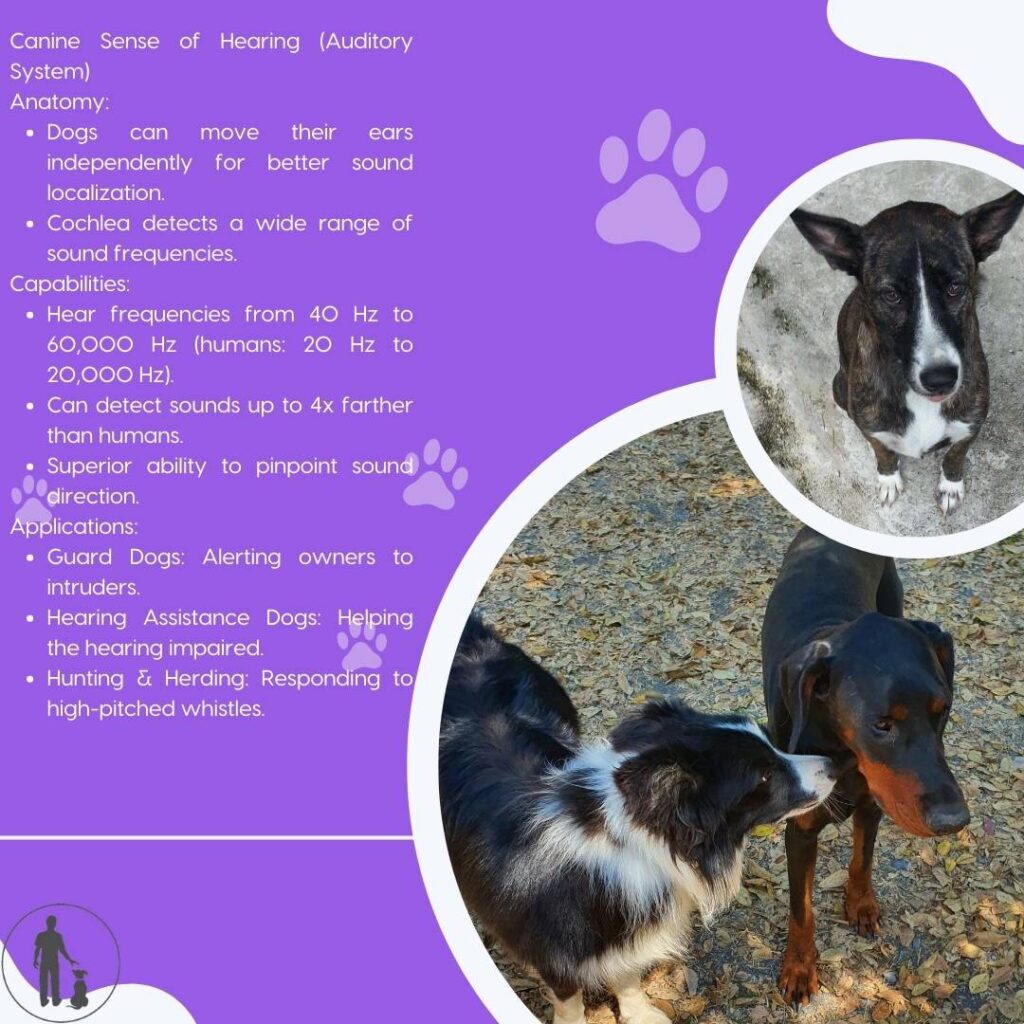
Guard Dog and Assistance Dog Roles
Dogs don’t just have sensitive noses; their keen hearing is put to good use in guard and assistance roles. Dogs have an exceptional hearing range, from 40 Hz to 60,000 Hz, which enables them to detect high-pitched sounds that are beyond human capabilities [Jones, Kokocińska-Kusiak et al., 2021]. This acute hearing is especially beneficial for guard dogs, who are trained to alert their owners to intruders or unusual sounds. Their presence alone can be a deterrent against potential threats, making them invaluable in security applications.
Additionally, hearing dogs play a crucial role in the lives of individuals with hearing impairments. These specially trained dogs assist by alerting their owners to essential sounds, like doorbells, alarms, and even crying babies. Their contributions are not just in practical assistance but also in providing companionship and enhancing their owner’s independence and quality of life.
Understanding the practical applications of dogs’ extraordinary senses opens up a world of possibilities and underscores the significant roles they play in our lives. These roles span from lifesaving search and rescue missions to enhancing daily living conditions for those with medical or sensory challenges. As we continue to explore and harness these abilities, we can expect even more exciting developments in how our four-legged friends assist us in ways we might not have imagined.
Communication and Behavior
Using Scent Marking and Pheromones for Communication
Dogs utilize their advanced olfactory system, which has around 300 million receptors, to communicate with other dogs through scent marking and the release of pheromones. This form of communication conveys critical information about territory, reproductive status, and individual identity. When a dog leaves its scent, it’s like signing a name on a message board. Other dogs can interpret these scent marks to understand who was there, their condition, and even their emotional state.
The vomeronasal organ, also known as Jacobson’s organ, plays a crucial role in detecting these pheromones. Located in the roof of the mouth, it’s especially sensitive to chemical signals. This system aids in interpreting signals about mating readiness and territorial boundaries, which are essential for social organization and reproduction.
Behavioral Responses to Specific Smells and Sounds
Dogs exhibit distinct behaviors in response to specific smells and sounds. For instance, the scent of food can trigger excitement and eagerness, whereas the smell of another dog’s urine might lead to investigative and territorial behaviors. Sounds also elicit strong responses. A dog might become alert and focused upon hearing a high-pitched whistle, while thunder could instigate a fear response.
These behavioral responses are deeply rooted in their evolutionary history, where detecting and interpreting scents and sounds were critical for survival. For example, the recognition of a predator’s scent or the sound of an approaching threat would have enabled timely evasive actions.
Importance of Sensory Stimulation for Mental Health
Sensory stimulation plays an essential role in maintaining a dog’s mental and emotional well-being. Engaging their senses through varied environments and activities helps to keep them mentally stimulated and prevents behavioral problems. Imagine being in a room with nothing to do – it wouldn’t be long before you felt bored or even stressed. Dogs are similar; a lack of sensory input can lead to issues like anxiety, depression, and destructive behavior.
Providing opportunities for exploration, play, and training that tap into their natural senses enriches your dog’s environment. Activities like scent work, interactive toys, and varied walks can significantly contribute to their happiness.
Understanding how dogs use their senses for communication and how they respond to their sensory environment is crucial in providing the care they need. By ensuring dogs have plenty of sensory stimulation and respecting their communication methods, we can better support their mental health and behavioral needs.
Training and Care Considerations
Understanding the unique sensory capabilities of dogs is crucial for developing effective training techniques and ensuring their overall well-being. This chapter delves into scent-based and sound-based training methods, managing dogs with sensory deficits, and enriching environments for optimal sensory stimulation.
Scent-based and Sound-based Training Techniques
Dogs possess an extraordinary sense of smell, with approximately 300 million olfactory receptors. This capability can be harnessed through scent-based training techniques such as nose work and search-and-rescue training.
Scent-Based Training:
- Nose Work: Engaging dogs in activities where they use their nose to locate hidden objects or specific scents can be highly stimulating. This could involve hiding treats around the house or creating scent trails for them to follow.
- Search-and-Rescue: Training dogs to find missing persons by following scent trails is another application. This technique utilizes their natural ability to detect and differentiate between various odors, making them invaluable in real-world scenarios.
Dogs also have a remarkable hearing range (40 Hz to 60,000 Hz) which can be leveraged for sound-based training techniques.
Sound-Based Training:
- Verbal Commands: Consistently using clear and distinct verbal commands helps dogs understand and respond to their handlers. This forms the basis of obedience training.
- Whistle Training: High-frequency whistles can be used to communicate over long distances or in noisy environments, where voice commands may not be effective.
Both scent-based and sound-based training play essential roles in a dog’s ability to assist in various tasks, from search-and-rescue operations to everyday obedience.
Managing Dogs with Sensory Deficits
Just like humans, dogs can experience sensory deficits such as loss of hearing or smell. Addressing these deficits requires understanding, patience, and tailored approaches.
- Hearing Loss: Dogs with hearing impairments may rely more heavily on visual and tactile signals. Hand signals or light signals can replace verbal commands. Vibrating collars can also be an effective tool for gaining a deaf dog’s attention.
- Loss of Smell (Anosmia): Dogs with compromised olfactory abilities may need modifications in their training and environment. Increasing visual cues and offering more physical engagement can help maintain their stimulation and well-being.
Empathy and creativity are key when adapting to the needs of dogs with sensory deficits. It’s important to remember that with the right strategies, these dogs can lead full and active lives.
Enriching Environments for Optimal Sensory Stimulation
Dogs thrive in environments that engage their senses. Providing varied environments and activities can significantly enhance their mental and emotional well-being, preventing behavioral issues.
Tips for Enriching Environments:
- Scent-Based Activities: Introduce new scents regularly, whether through scent trails, puzzle toys, or rotating their toys. This keeps their sense of smell sharp and engaged.
- Auditory Stimulation: Vary sounds in their environment, from different types of music to recordings of nature sounds. Auditory stimuli can be particularly beneficial for puppies and senior dogs.
- Physical and Mental Challenges: Agility courses, puzzle toys, and interactive play sessions can engage a dog’s mind and body, keeping them active and happy.
By incorporating these elements into their daily life, you not only support their natural instincts but also contribute to their overall health and happiness.
As we explore further into the unique abilities and needs of dogs, it’s clear that understanding and nurturing their sensory worlds is essential. This knowledge helps in creating a harmonious and fulfilling life for our canine companions.
Future Developments
Ongoing Research in Canine Sensory Capabilities
Understanding and leveraging the incredible sensory capabilities of dogs is a growing field of scientific interest. Research is delving deeper into the genetic basis of olfactory and auditory abilities, aiming to uncover the full extent of what dogs can perceive and how they do it. Genetic studies are particularly focusing on the variations in olfactory receptors and the implications of these differences on scent detection. Discoveries here could lead to more specialized breeding and training programs, improving dogs’ abilities in specific tasks such as detecting diseases or explosives. Moreover, understanding the genetic underpinnings of hearing can help in identifying and managing hereditary hearing impairments.
Emerging Technologies and Applications
As our understanding expands, so does the potential for innovative applications. New technologies are emerging to assist dogs in honing their remarkable senses and compensating for any deficits. For instance, scent-detection devices are being developed to mimic a dog’s olfactory capabilities, but these technological ‘noses’ still lag behind their natural counterparts. Meanwhile, gadgets designed to aid dogs with hearing impairments, such as vibrating collars that respond to specific sounds, are gaining popularity.
Medical alert dogs are another exciting area where canine sensory capabilities are applied. These specially trained dogs can detect changes in their human companions that signal medical issues are imminent, such as a drop in blood sugar levels in diabetics. Continuous advancements in this field promise to refine how these dogs are trained and utilized, making life-saving interventions more accurate and reliable.
Potential Improvements in Training Methods

As research progresses and new technologies emerge, training methods for working dogs are continually being refined. Traditional practices are being supplemented with data-driven approaches, using insights from research to enhance the effectiveness and efficiency of training programs. For example, trainers are increasingly using scent ‘imprinting’ techniques at an earlier stage in a dog’s development. This method helps dogs become even more proficient at identifying and distinguishing between specific scents.
Similarly, advancements in understanding the auditory capabilities of dogs have led to the development of more sophisticated sound-based training techniques. These include specialized sound frequencies and directional sound cues that can be used to train dogs more precisely, enhancing their ability to respond quickly and correctly in various situations.
Enrichment and Well-Being
A key focus of future developments also lies in improving the overall well-being of dogs by enriching their sensory environment. Research highlights the importance of sensory stimulation for mental and emotional health. By providing a variety of scents and sounds in their environment, owners can help keep their dogs engaged and mentally stimulated, reducing the risk of behavioral issues arising from boredom or frustration.
In conclusion, the future looks promising for leveraging canine sensory capabilities. Whether through ongoing genetic research, the application of new technologies, or the refinement of training methods, we are on the cusp of remarkable advancements that will benefit both dogs and humans alike.

